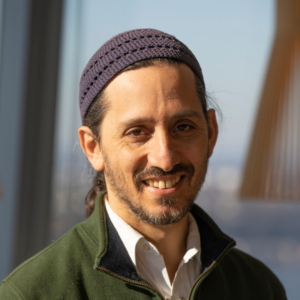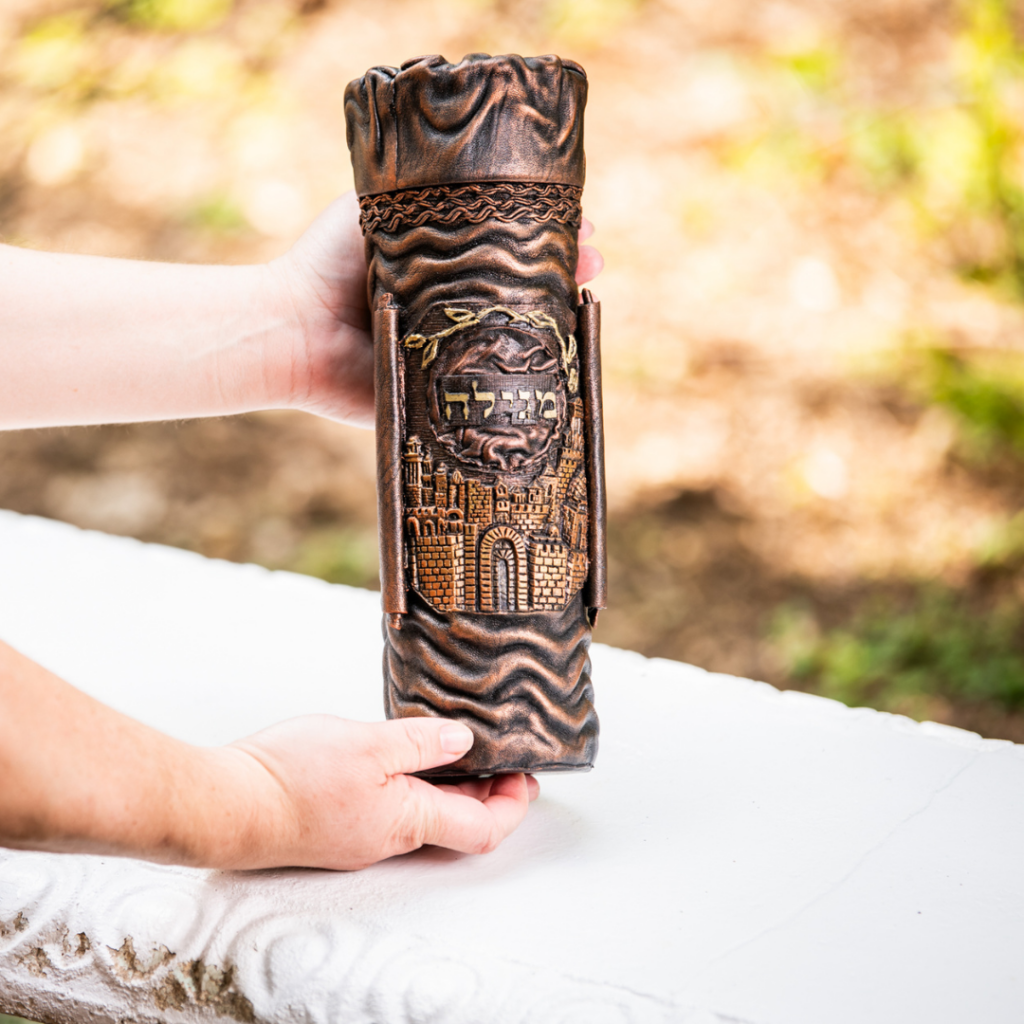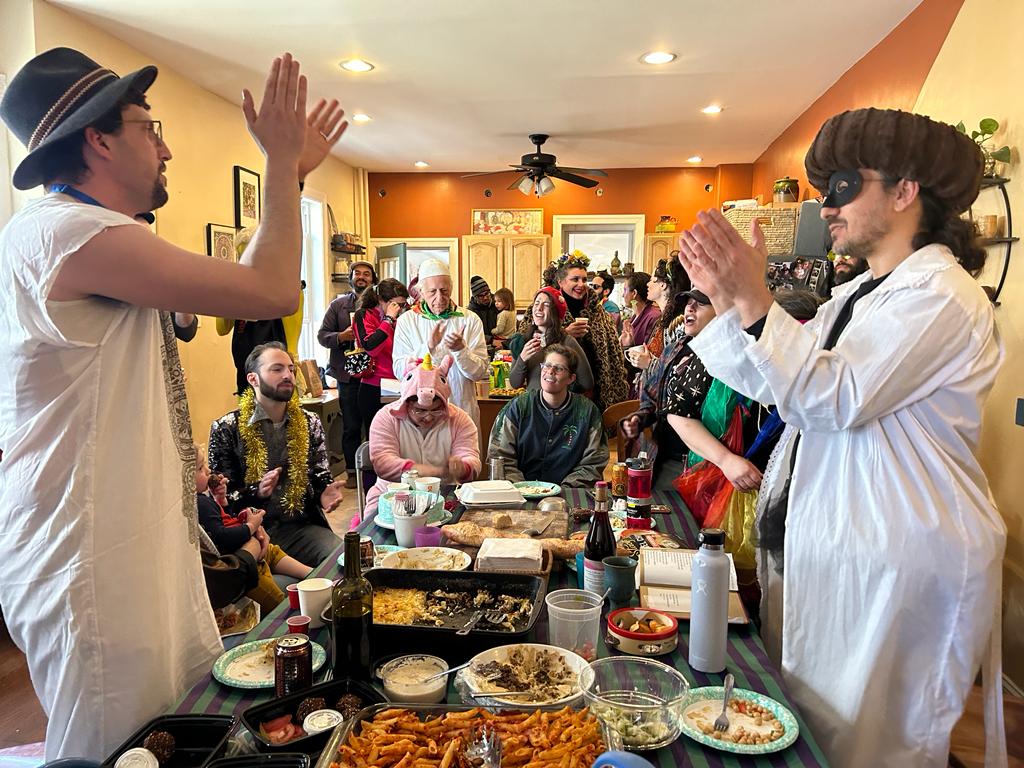
Reb Ezra Weinberg
Shaliach tzibur, officiant and Jewish educator
Before there was the March Madness of college basketball, there was the March Madness in Shushan, Persia. Similar to the NCAA tournament, Purim is the epitome of the “go big or go home” holiday.

If you are not now nor ever have been a Purim person, chances are that you have not experienced the full Purim. And it’s not easy. Purim demands maximum effort. Unlike Hanukkah and Rosh Hashanah, you can’t go halfway with Purim and expect to be satisfied.
How does one up their Purim game? My experience of this holiday radically shifted when I fully learned about the fourth mitzvah — the Purim Seudah, also known as the festive meal. Most of us are more familiar with the other three mitzvot: Megillah: hearing the story; Matanot L’evyonim: giving to the poor; and Mishloach Manot: gifts of food to friends. Those are all essential ingredients to an authentic celebration. But I see those first three mitzvot as cogs in the dramatic build-up to the apex fourth mitzvah: the seudah. The Purim seudah is unique among all Jewish rituals. Why? Because it reveals the unseen and often underappreciated genius embedded in this ancient holiday. Just the name of this mitzvah reveals one of the many misdirections inherent in Purim. The seudah isn’t really about the meal; it’s a cover for a mystical party of paradox. What follows are three ingredients to what makes an unapologetically awesome Purim seudah: the setting, the vibe and the Torah.
1. Setting: The seudah happens during the daytime. Purim is a 25-hour holiday. After one comes home from shul in the evening from hearing the megillah and goes to bed, when they wake up, it’s still Purim and will be until sunset. And while it is customary to hear the megillah again in the morning, the seudah is the primary daytime activity. Everything in the Jewish calendar is building up to this festive meal. The Fast of Esther, which is the day before Purim, and the Torah reading from the previous Shabbat (Shabbat Zachor), which commands us to remember Amalek, an ancestor to Haman — both of those rituals are prepping us for Purim. The pressure builds to make this holiday an eruption of sorts. But you can’t fully experience the release if you don’t create the space to celebrate, which is the entire point of the seudah: the full unadulterated expression of Purim. It means not going to work (or leaving early) and attending a mysterious daytime party in costume. In fact, it is the only one of the four Purim mitzvot that must be performed in the daytime.
And where do you have the seudah? More often than not, in people’s homes and not in synagogue. Like the sukkah, the seudah is an opportunity to invite people into something different and ancient. But the unpredictable energy of the seudah experience is very different than the gratitude/hospitality vibe of the sukkah.
Let’s talk about that Purim vibe.

2. The Vibe: Seudah is the Hebrew word for “festive meal.” There is definitely food at a seudah. In fact, it would not be a proper seudah without a full meal. And yet, unlike almost every other festive meal within Judaism, the experience is not centered on eating. This is demonstrated by the lack of a kiddish and no special blessings before the meal. There is a paragraph added to the blessing after the meal about the miracles associated with Purim. Traditionally, drinking alcohol is a staple of the seudah. How much does one drink? It depends. There is a custom of ad de lo yada, meaning “until one cannot distinguish between Haman and Mordechai.” But in contemporary seudot, drinking is not required nor is it actually necessary. Drinking is but one path of many to achieving the “Purim state.”
At its most basic, the seudah is a costume party with one basic theme that comes straight out of the megillah: V’nahafochu — a full reversal. For one day, every interaction is framed by the following: “What we thought was true … turns out to be the exact opposite.” That is the reason for the costumes. For one meal, we take on new identities and imagine that we are hiding our true selves the entire year only to reveal our truest selves today. Just as Queen Esther had to hide her Jewish identity to the king, so, too, do we embrace the constant paradox that so much of the truth of the universe is hidden before our naked eyes. The Purim seudah is our greatest opportunity to take off the mask by putting one on. That is Purim logic.

At its heart, the seudah is deep playfulness for adults! It’s the one day we give ourselves permission to let down our guard and be existentially silly. And it is actually designed as a fully adult experience. It should be child-friendly, but not child-centered. Ideally, the seudah is an activity where children should aspire to attend fully and appreciate as they grow older.
3. Purim Torah: Embedded with Purim’s DNA is taking every opportunity to create confusion through the broadcasting of opposites. The central plotlines in the megillah illustrate how the fate of our people can transform quickly. We go from imminent annihilation to a shocking military victory. Impossibility transforms into inevitability. Light is dark, and dark is light. And all this without the mention of God. God, like so much else, is hidden. The implicit goal of the seudah becomes, in a lighthearted way, to hide the obvious and reveal the hidden truths of our lives, our people and our fate. That is Purim Torah. Somehow, it works. What a gift to ourselves.
Purim Torah must be is accessible to anyone, no matter how learned and how new to Judaism, yet requires just a little order to manage the chaos. But what kind of structure could possibly hold this level madness?
The tisch. You might be more familiar with the wedding tisch or the Shabbat version, often called a farbrengen. The tisch brings song, silence, lechayims, dance, and most importantly, words of Torah together in one place. What exactly are words of Torah in the Purim context? Are they carefully crafted divrei Torah/sermons like the ones you hear in synagogue? Yes and no. One can prepare for a Purim seudah tisch, but ideally, words of truth and Purim truth will also emerge from the heart spontaneously. Silly and serious jumble together. It doesn’t have to make sense but must be treated as sacred. Ultimately, as it builds and builds, the tisch should take on a life of its own where new ideas and songs emerge, and spontaneous Torah is spewed.
No one is criticized. Heckling is permitted, but monitored by the participants and shouldn’t prevent self-expression. The participants are meant to encourage each other to bear their hearts on the altar of the Purim table. Each layer of Torah and each song builds upon each other. Politics are turned on their head. Comedy is inherent. Sheer nonsense is praised.
I’ll conclude with an example of Purim Torah from the seudah I went to last year. There was an impromptu upshirin (first haircut) for a child who was born three years prior on Purim. As is traditional, on a boy’s third birthday, the community gathers to witness the shearing of his first locks. As the father of this boy introduced the ritual to a crowd of adults all in costume, he described the tension of doing one ritual in the context of another. He said, “Purim is a day for opposites. It’s a day when the organizers get disorganized.” Then someone else spoke and made the important connection of Purim to Yom Kippur, or as it’s also known, Yom K’Purim — (the day that’s like Purim) And as the upshirin was ending and we all lined up to cut the hair of this joyful child, we spontaneously broke out in song an upbeat version of “Avinu Malkeynu.” We sang it both with the piety of Yom Kippur and the absurdity of Purim in wondrous merriment.










